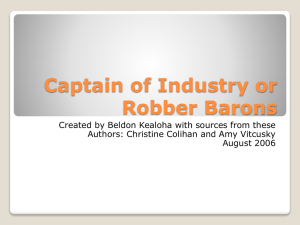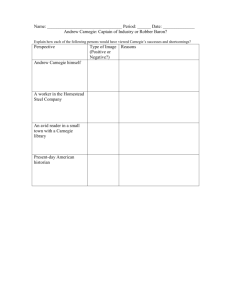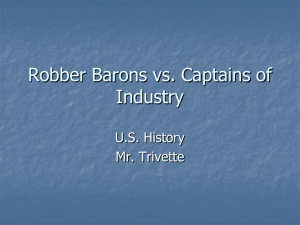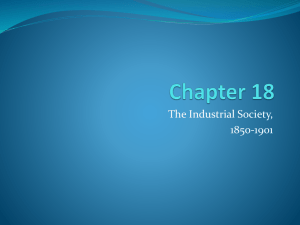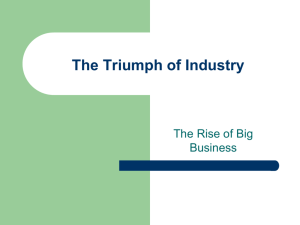n06_Rise in Industrialism - The School of Arts and Enterprise
advertisement
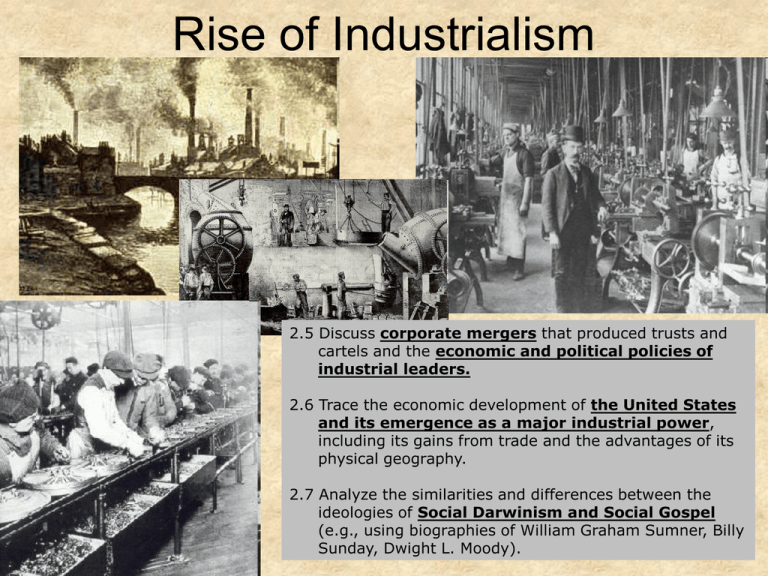
Rise of Industrialism 2.5 Discuss corporate mergers that produced trusts and cartels and the economic and political policies of industrial leaders. 2.6 Trace the economic development of the United States and its emergence as a major industrial power, including its gains from trade and the advantages of its physical geography. 2.7 Analyze the similarities and differences between the ideologies of Social Darwinism and Social Gospel (e.g., using biographies of William Graham Sumner, Billy 1 Sunday, Dwight L. Moody). WHY the US emerged as an industrial giant 19th and 20th century •railroads •steam power •oil refining •steel •electrical power •machine tools •factory equipment •rubber •communications 2 Laissez faire ■“Hands off” ■Belief that government should not intervene in business or the economy Adam Smith wrote about Laissez faire in his book Wealth of Nations, 1776 3 “Social Darwinism” (Herbert Spencer ) •Competition was “the law of life” and resulted in “survival of the fittest”. •The unfit would eventually disappear because they could not compete. •Government aid to the poor interrupted the social evolution “Each individual should be allowed to do as he or she wills as long as it doesn’t infringe on the rights of another person.” 4 Spencer’s Social Darwinism Opposed government aid to the poor Against a public school system Opposed laws regulating housing, sanitation, and health Disease was punishment for the ignorant Against most taxes Against regulating working conditions: NO maximum hours NO minimum wages NO labor unions 5 The Gilded Age: A Tale of Today (1873) A novel by Mark Twain and Charles Dudley Warner Explored political and economic corruption Twain “Gilded” means to be covered on the outside with gold. The novel to refers to a city, which from a distance, looked as if it was made of gold, but instead, was covered in cheap gold paint. Warner Why do you think this era in US history is called “the gilded age?” 6 Problems with growth • Business dominated. • Working conditions unsafe • Cities could not house or police growing populations. 7 Industrial Leaders: Heroes or Villains? 1."Captains of Industry” some people viewed Industrial leaders as heroes who progressed the American economy with their business skills. 2. "Robber Barons” Some viewed Industrial leaders as immoral, greedy, and corrupt, using bribery, illegal business practices, and cruelty to workers to get ahead. 8 Robber Barons Late 1800’s - a handful of these businessmen controlled over 90 percent of total U.S. wealth. commonly known Robber Barons include: John D. Rockefeller Cornelius Vanderbilt Andrew Carnegie J. Pierpont Morgan 9 John D. Rockefeller 1839-1937 1860 - Saved money as a clerk to start a business selling farm tools 1862 - developed cheap oil refining. Started the company: Standard Oil. 10 Standard Oil • Rockefeller dominated the oil industry • Put local companies out of business with aggressive tactics and lower prices. • 1890 - Standard Oil was a monopoly (no competitors) • Rockefeller was worth about $9 billion dollars ($200 billion in 2009 dollars). 11 Cornelius Vanderbilt 1794-1877 As a teen, borrowed money from parents to buy a boat for passengers between Staten Island and New York City 1829 - formed a steamship company on the Hudson River; charged lower fares than his competitors 1860s - invested in railroads and New York’s Grand Central station he died worth $100 million ($1.7 billion in today’s dollars) 12 Vanderbilt like many other robber barons, built massive mansions and spent huge amounts of money Vanderbilt mansion today in Hyde Park, NY This bedroom is a reproduction of a French Queen's chamber from the Louis XV period. William Vanderbilt took over the family business 13 Andrew Carnegie 1835-1919 Carnegie was born in Scotland to poor parents and emigrated to the U.S. at 13. Made some money by being recognized by his bosses as a honest and hard worker 1865 - invested in iron bridges and iron industry Invested in Bessemer process for making cheap steel Dominated industry with Carnegie Steel Corporation Different from other robber barons –Supported worker’s right to unionize 14 Making steel using the Bessemer process 15 16 17 J. P. Morgan 1837-1913 Born into a wealthy family Formed J.P. Morgan and Company Made $ by loans to railroad companies in financial trouble Believed monopolies were best for our economy 1901 – bought Carnegie Steel Corp. and created U.S. Steel, the first $billion corporation Early 1900s - Morgan dominated almost all major industries 18 J.P. Morgan lived his life on a large scale, spending massive amounts of money, gambling, on “toys” like yachts, huge parties, palatial homes and art. “If you have to ask how much it costs you can’t afford it”, typifies his beliefs about money. 19 What does this cartoon portray? The millions made by the robber barons is at the expense of the workers 20 Carnegie attacked the rich of his time. Believed the rich have a duty to help the poor. 21 The Gospel of Wealth, by Andrew Carnegie • Argued that the wealthy had an obligation to give away their money. • Donated to over 3,000 public libraries and education including the creation of several universities • “he who dies rich, dies in disgrace.” 22 Carnegie Hall The nonprofit Carnegie Hall Corporation was created to run the venue. It was designated a National Historic Landmark in 1962. 23 Carnegie Library of Pittsburgh 24 How do robber barons compare to Microsoft founder Bill Gates? 200 180 160 140 120 100 80 60 40 20 0 Rockefeller Carnegie Vanderbilt Bill Gates Jay Gould JP Morgan James H. Hill $ billions $ 25 Summary • It will make you intellectually rich 26

